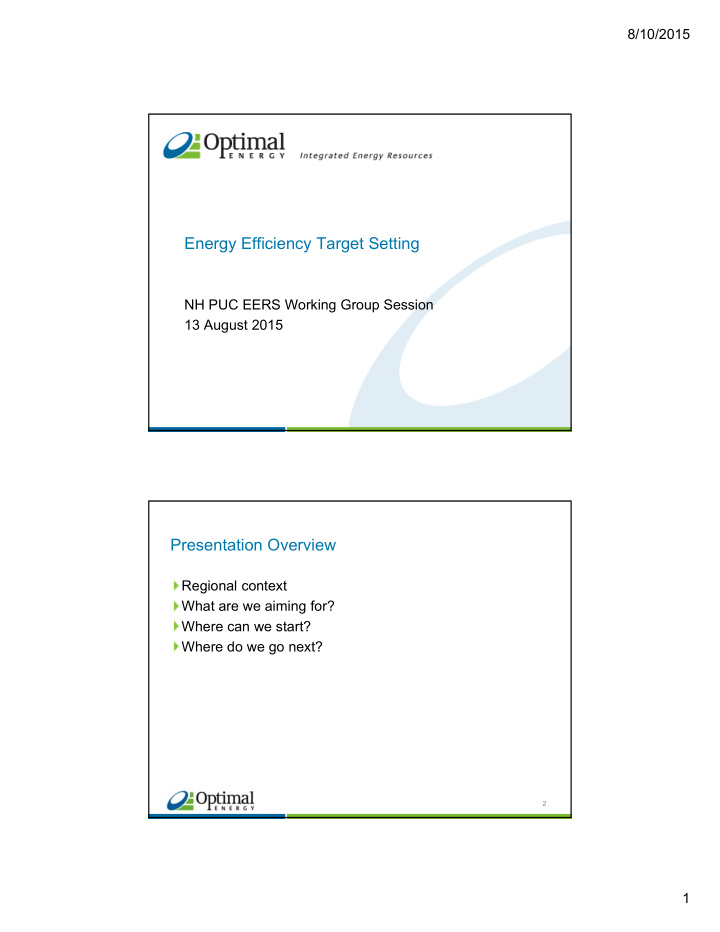



8/10/2015 Energy Efficiency Target Setting NH PUC EERS Working Group Session 13 August 2015 Presentation Overview Regional context What are we aiming for? Where can we start? Where do we go next? 2 1
8/10/2015 New England leads the nation in EE… 4.0% Rhode Island Massachusetts 3.5% Connecticut Maine 3.0% Electric savings as a % of sales Vermont 2.5% 2.0% 1.5% 1.0% 0.5% 0.0% 2009 2010 2011 2012 2013 2014 3 …but New Hampshire is an outlier 4.0% Rhode Island Massachusetts 3.5% Connecticut Maine 3.0% Vermont Electric savings as a % of sales New Hampshire 2.5% 2.0% 1.5% 1.0% 0.5% 0.0% 2009 2010 2011 2012 2013 2014 4 2
8/10/2015 Good policy balances the needs of stakeholders Equity Environment Cost Benefits 5 Beginning with a common understanding Much of NH load served by utilities achieving high savings Funding constraints ≠ all cost-effective efficiency EE is cheapest supply, particularly in light of… A changing landscape – Clean Power Plan – Inexpensive but constrained gas supply – Distributed and customer-owned/sited generation – “Naturally-occurring” efficiency 6 3
8/10/2015 Suggested target-setting process Set targets Allow PAs to develop portfolio and budgets – Encourage, but don’t require, multiple sources PUC reviews, approves, and establishes necessary funding, considering all factors 7 Targets higher than Staff proposal are possible “Mature” incremental annual savings of 2% electric, 1% of gas Five year “ramp-up” is feasible 3.0% 2.5% 2.0% Rhode Island Massachusetts Maryland 1.5% NH (OEI) Delaware 1.0% NH (Staff) 0.5% 0.0% 2015 2016 2017 2018 2019 2020 8 4
8/10/2015 Other considerations in target-setting Long-term targets are good – Potential is already established – Consider update in mid-term Short-term targets should be at least 3 years – More certainty, advantages of multi-year contracts and planning – Consider cumulative targets as benchmark Up-front agreement on what “counts” – Minimum average measure life or other “floor” – “Before-the-meter” savings (e.g., CVR/Volt-VAR) – Fuel-switching, CHP, other DG, codes and standard 9 Other considerations, continued Consider mandatory targets with penalties and incentives – Beware of perverse incentives – Consider non-financial “penalties” Decoupling to address lost revenue – Provides other ratepayer and utility benefits – Reduction in PI may be needed if decoupled 10 5
8/10/2015 What is cost-effective? Total Resource Cost (TRC) test best reflects overall economic impact – Include all reasonably-quantifiable costs and benefits (NEBs, DRIPE) – Lost revenue is not a cost – Focus on program and portfolio – Flexibility for measures and for LI programs …and you don’t need a potential study! 11 Lost revenue is not a cost 120% 100% Revenue as a % of "No EE" revenue 80% EE spending variable costs 60% LR adjustment fixed costs 40% 20% 0% EE, no LR No EE EE, LR 12 6
8/10/2015 Thanks, we hope this has been helpful! Phil Mosenthal, Jeff Loiter Optimal Energy, Inc. 10600 Route 116, Suite 3 Hinesburg, VT 05461 802-482-5600 7
Recommend
More recommend